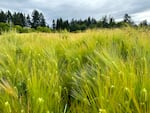On the outskirts of Corvallis, Oregon, a group of farmers, scientists and food makers is walking through a field of waist-deep barley. It’s a sea of colors ranging from electric green to pale gold to deep purple, with most of the barley growing hair-like bristles that make the field look like it has a blurring filter when the wind blows.
The fields may have vibrant colors, but they are also mostly naked, something Brigid Meints gets a kick out of explaining to the crowd.
“We like to say ‘naked’ because we like to make some good puns,” she laughed. “Instagram tried to take my Instagram down for being @nakedbarley.”

Brigid Meints walks through of a field of naked barley outside Corvallis, Ore., on June 4, 2024. Meints is a barley breeder at Oregon State University and project director of a multimillion-dollar grant to study naked barley.
Crystal Ligori / OPB
Meints is an assistant professor (senior research) at Oregon State University and says the “naked” naming convention also helps limit confusion for the consumer.
“We don’t like to say ‘hulled’ or ‘hull-less’,” said Meints, “Because if you go to the market and see something labeled as hulled, they actually mean de-hulled [and] that’s confusing.”
All barley grows with an outer husk or hull around the grain which needs to be removed to make it palatable for people. In covered barley, that hull is essentially glued to the grain, but for naked barley the grain is loosely covered, making it free-threshing, like wheat or rye.
“Naked barley is very similar to covered barley genetically,” she said. “It’s a single gene difference — a mutation that occurred, we think, about 8,500 years ago.”
Having the hull thresh off during the harvesting not only makes the grain easier for farmers to process, it also makes the barley more nutritious.
“Pearled barley is probably the most common way that people have eaten barley, that’s hulled barley where the hull is polished or abraded, similar to rock polishing,” she explained. “But that process also removes some of the bran and the germ, where a lot of the minerals and micronutrients are located.”
And that could be key to making barley the next big thing in food. Right now, about 95% of barley grown in the U.S. is either used as animal feed or malted for beer, but a multimillion-dollar research grant to OSU could change that. Meints is the project director of the grant from the USDA’s National Institute of Food and Agriculture. The goal is to develop multi-use naked barley for organic farming systems, with a focus on creating a variety that appeals to chefs, brewers, distillers and farmers.
“Even though I’m a plant breeder, I’ve also sort of ended up having to market the crop as well,” she said. “And one of the ways that I do that is I feed people [so] they can get to taste how amazing barley is.”

Andrew Ross stands in the OSU research bakery with a tray of cookies and muffins made with naked barley on June 4, 2024. Ross is a professor of cereal chemistry at OSU and uses the research bakery to develop recipes with naked barley.
Crystal Ligori / OPB
Helping Meints get naked barley into the mouths of the public is Andrew Ross, a professor in the Crop and Soil Science and Food Science and Technology departments at OSU. Ross runs the research bakery on the OSU campus which is part science lab, part commercial kitchen. He jokingly refers to himself as “Brigid’s baker” since it’s his job to use the varieties she develops to push the limits of how much barley can be added to a particular product.
“It is very, very difficult to make bread with just barley,” Ross explained. “Risen breads we really struggle to add a lot of barley to, but pita breads have worked really well.”
He’s also had success using barley in other types of flatbreads, cookies, and muffins, as well as some more surprising snacks.
“Somewhere along the line we had the idea to nixtamalize the barley and make corn-style tortillas out of them,” Ross said. “And they’ve been really, really well received.”

OSU food science master's student Sydney Baumgardner (right) prepares a dough made of nixtamalized naked barley (left) for tortillas in Corvallis, Ore., on June 4, 2024.
Crystal Ligori / OPB
And that’s important because if you want people to start eating more barley, it has to taste good. But Ross has another reason to get barley onto people’s plates.
“I have a professional and personal vendetta to encourage people to eat more whole grains, because the scary and well-documented statistic is that 95% of the U.S. population does not even get the FDA approved amount of fiber per day.” he said. “It’s a public health disaster.”
Even with all the research and testing Ross and his team do, he says getting barley into real kitchens with chefs and home cooks will be the true test.
“I think it’s a really grounding perspective to be a research scientist and then have someone come to me and say, ‘Well, that’s just not practical,’” he said.
Which is why part of the research grant will focus on partnerships with restaurants. Over the coming years, 10 Pacific Northwest restaurants will be tapped to host naked barley “pop-ups”, incorporating a naked barley-based item on their menus.

A research field of naked barley outside Corvallis, Ore., on June 4, 2024. Oregon State University just received $3.5 million to study naked barley.
Crystal Ligori / OPB
